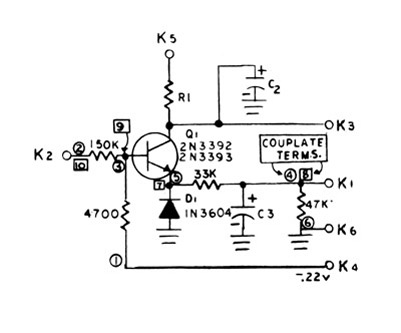X 66
North Suburban HAMMOND ORGAN Service
X 66 Proportional Keyer
The next item to consider in the X66 organ are the proportional keyers. Here is one specific area where the X66 differs significantly from the traditional tonewheel Hammonds. Recall that drawbar volume on a traditional Hammond is determined by which tap on the matching transformer a particular drawbar is sending its signal to via the drawbar busbars.
Figure 11.

In the X66, the drawbar volume is determined by the output(s) of the proportional keyers which are actually variable gain amplifiers. The output of a proportional keyer varies with a negative DC voltage which is applied to the emitter circuit of the transistor amplifier. Each of the nine drawbar busses carries a higher negative DC voltage than the previous, so pulling out a drawbar applies a progressively more negative voltage to the proportional keyer, resulting in an increased signal output.
When you push a key, this voltage is applied to the keyer via terminal K1 through a resistance.
(For convenience, we'll use Hammond's part numbering.)
All of the proportional keyers (there are 97 of them) are alike with the exception of resistors R1 and capacitors C3. With no voltage applied to K1, the keyer output is zero. As in any type of circuit where we are actually keying a DC voltage, instantaneous keying would cause a loud bang or thump to be heard. Recall in the description of the Wurlitzer electrostatic that the reed pickups had to be keyed through small resistor/capacitor networks, Likewise, the proportional keyers of the X66 must be keyed so that the audio output is not completely instantaneous. The function of capacitor C3 is to retard the keying and eliminate keying thumps. The capacitor values range from 0.1 uF to 0.33 uF. Terminal K3 is the keyer signal output, K5 is DC voltage in.
In the X66 console, there are preset panels similar in appearance to those of traditional Hammonds, but they are controlling DC keying voltages instead of audio signal levels. When a drawbar is pulled all the way out, the voltage is around -100V, so it is necessary to shut down the instrument when changing preset wiring combinations to prevent getting a shock.
Previous Page Page 9. Next page